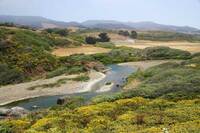- England
- Scotland
- France
- Holland
- Germany
- Italy
- Spain
- Portugal
- USA
- China
- Japan
- India
- Iran
- Advice
- Gardens
- England
- Scotland
- France
- Holland
- Germany
- Italy
- Spain
- Portugal
- USA
- China
- Japan
- India
- Iran
- Advice
- Garden Tours
Book: Landscape Planning and Environmental Impact Design: from EIA to EID
Chapter: Chapter 11 Urbanisation and growth management
Urbanisation changes the pattern of surface water drainage. [Fig 11.16] shows the pattern of streams and ditches in Bracknell before and after construction of the new town. It can be seen that many watercourses have been filled, or culverted, in order to improve their flow capacity and prevent children from playing in the water. This was the standard method of dealing with surface water runoff in the early days of the new towns. The 1952 Master Plan Report on Bracknell has the following section on surface water drainage: For all practical purposes no surface water sewers exist in the area at present, and it is therefore necessary to construct considerable lengths of trunk sewers to deal with the great increase in the quantity of surface water which will run off from the area when all the new roads, buildings and other paved areas have been constructed. At present much of the rainwater drains away into the ground. The question of whether the Down Mill Stream and the Bull Brook should be culverted or widened to take this additional discharge has been very carefully considered, and the Corporation decided to culvert the former on the length north of the railway to make provision for the future widening of the Designated Area. The present flow in The Cut below the confluence of the two streams in times of storm has been estimated to reach a rate of 5,300,000 gallons per hour; it has been estimated that when the town has been built the rate of flow will rise to 18,400,000 gallons per hour (Bracknell Development Corporation 1952: 11). Although the new towns' record for culverting streams is bad, they have a better record than most urban areas in Britain for storm detention (Hall & Hockin 1980). In 1985 Bracknell had 11 storm detention facilities and 6 of them were wet basins. As discussed in Chapter 9, the practice of reducing the number of streams and accelerating the rate of runoff by installing paving and drainage has greatly aggravated the downstream flood problem. Redditch was one of the first British new towns to experiment with the retention of streams in housing areas. In Matchborough the stream was kept as a basis for the main open space provision in the housing area. It is a delightful feature and very popular with children [Fig 11.17]. A hydrological survey revealed that sufficient water would remain in the stream despite the fact that 'much of its catchment area would be cut off by the new development' and removed in underground pipes. At one point the stream is piped beneath an estate road and a ford has been built over which the water flows in times of peak discharge. The idea of using natural streams and ditches for urban stormwater drainage has been developed to a greater degree in America. At Woodlands, 35 miles north of Houston in Texas, a new community is being built on a site of over 8,300 hectares. The developer wished to create 'a more satisfactory suburban living environment' and appointed Wallace, McHarg, Roberts and Todd to prepare a master plan (Juneja & Veltman 1979). Since the site was flat and badly drained it was necessary to keep the soil wet enough to preserve the woodland, yet dry enough to permit residential development. These objectives were achieved by using a 'natural' drainage system instead of storm water sewers. All the drainage water at Woodlands is retained on site using storm detention basins and, wherever possible, existing streams and ditches. Building development is clustered on impervious soils which were occupied by vegetation of low diversity. The more permeable soils, with denser and more diverse vegetation, are protected so that surface water can seep downwards and recharge the aquifer. Roads and golf fairways direct surface water towards the recharge areas. It is anticipated that when the site is fully developed 15 million gallons of water per day will be withdrawn from the aquifer. The developer, Woodlands Development Corporation, estimated that a natural drainage system for the whole site would cost $4,200,400 as against $18,679,300 for a conventional underground storm water drainage system. McHarg comments that 'Such figures accelerate conversion to ecological principles. There is no better union than virtue and profit' (McHarg & Sutton 1975). The system also works well: on 18th April 1979 'no house within the Woodlands flooded while all adjacent subdivisions were awash' (Juneja & Veltman 1979). Careful treatment of wetlands and waterspace is an excellent way of generating landscape character on flat sites. In Europe, it would be worth initiating a new settlement purely for the purpose of developing and testing new methods of urban stormwater management. It would be lush, soft, squelchy, quiet and rich in wildlife.
